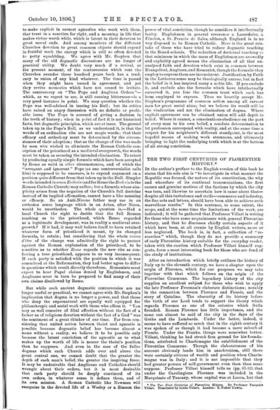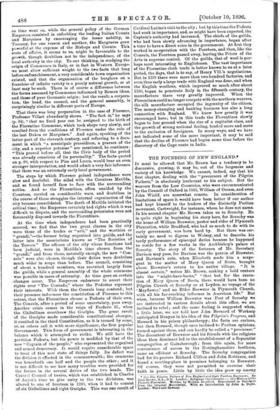THE TWO FIRST CENTURIES OF FLORENTINE HISTORY.*
IN the author's preface to the English version of this book he states that his sole aim is "to investigate in what manner the Republic was formed, the nature of its constitution, the why and wherefore of its continual transmutations, the first causes and genuine motives of the factions by which the city was torn, and likewise to ascertain how it came about that— despite all this turbulence and strife—commerce and industry, the fine arts and letters, should have been able to achieve such marvellous results." In this sentence, to some extent, the scope, and at the same time the limitations of the work, are indicated ; it will be gathered that Professor Villari is writing for those who have some acquaintance with general Florentine history, and that he discusses chiefly certain aspects of it which have been, at all events by English writers, more or less neglected. The book is, in fact, a collection of "re- searches " which, though they do not provide a summary of early Florentine history suitable for the everyday reader, taken with the caution which Professor Villari himself sug- gests, form a most interesting book for those who are fond of the study of institutions.
After an introduction which briefly outlines the history of Italy up to the eleventh century, we have a chapter upon the origin of Florence, which for our purposes we may take together with that which follows on the origin of the Florentine Commune. The legendary history of the city supplies an excellent subject for those who wish to apply the late Professor Freeman's elaborate distinctions; notably in the connection between Florence and Fiesole, and the story of Cataline. The obscurity of its history before the birth of our Lord tends to support the theory which regards Florence as one of the colonies which Sults founded. Roman Florence has little importance, and the same can almost be said of the city in the days of the Goths and the Lombards. Under the latter, indeed, it seems to have suffered so much that in the eighth century it was spoken of as though it had become a mere suburb of Fiesole. Under the Franks, things were somewhat better. Villani, thinking he had struck firm ground for his founda- tions, attributed to Charlemagne the establishment of the Florentine Commune. Though the elaborateness of his account obviously lands him in anachronism, still there were certainly citizens of wealth and position when Charle- magne was in Italy; and it is not impossible that they had greater powers of self-government even then than some suppose. Professor Villari himself tells us (pp. 81-82) that under the Carolingiens Florence was included in the Marquisate of Tuscany, whose capital was at Lucca, but that- Two First Centuries of Florentine History. By Professor Pasquale
as time went on, while the general policy of the German Emperors consisted in enfeebling the leading Italian Counts and Marquises by encouraging the lesser nobility, in 'Tuscany, for one reason and another, the Margraves grew powerful at the expense of the Bishops and Counts. This state of affairs, it seems to us, might be favourable to the growth, though doubtless not to the independence, of the local authority in the city. To our thinking, in studying the origin of Communes in Italy, or in fact in Western Europe, we must allow sufficient weight to the two facts that long before enfranchisement, a very considerable town organisation existed, and that the organisation of the burghers on a -franchise of infinite variety is a purely natural growth, or at least may be such. There is of course a difference between the forms assumed by Communes influenced by Roman ideas, and those of pure Germanic origin ; but the result, a corpora- tion, the head, the council, and the general assembly, is surprisingly similar in different parts of Europe.
That there was long preparation in the case of Florence, Professor Villari abundantly shows. " The fact is," he says i(p. 84), "that no fixed year can be assigned to the birth of the Florentine Commune, which took shape very slowly, and resulted from the conditions of Florence under the rule of the last Dukes or Marquises." And again, speaking of the latter part of the eleventh century, and referring to a docu- ment in which "a municipale praesidium, a praeses of the 'city, and a superior potestas " are mentioned, he continues : " This proved before all, that the Civic body of the period was already conscious of its personality." The facts quoted on p. 90, with respect to Pisa and Lucca, would bear an even stronger interpretation, and would admit a very fair inference that there was an extremely early local government.
The steps by which Florence gained independence were -slow and doubtful She sided with the Countess Matilda, and so found herself face to face with the surrounding nobles. And so the Florentines, often unaided by the 'Countess, carried on considerable wars, and doubtless in the course of these struggles the internal organisation of the -city became consolidated. The death of Matilda initiated the critical time ; the Emperors certainly had rights which it was 'difficult to dispute, and the surrounding potentates were not favourably disposed towards the Florentines.
At the time when independence had been practically 'secured, we find that the two great classes in the city were those of the trades or " arti," and the worthies or
grandi,"—the former being organised into guilds, and the latter into the associations known as "The Societies of the Towers." The officers of the city whose functions had been judicial, were in Matilda's time chosen from the " grandi," and from these, naturally enough, the new "Con- suls " were also chosen, though their duties were doubtless much wider in scope than before. The council, consisting -of about a hundred members, was recruited largely from the guilds, while a general assembly of the whole commune was possible in cases of extremity. As time goes on certain 'changes occur. The Emperors endeavour to assert their rights over " The Contado," where the Podestas represent their interests. With them the Consuls long contend; but their presence influences the constitution of Florence to this 'extent, that the Florentines choose a Podesta of their own. The Consuls, after a period of some uncertainty, pass away. Another crisis comes in the reign of Frederic II., when the Ghibellines overthrew the Guelphs. The great revolt of the Guelphs made considerable constitutional changes it resulted in the third Constitution, as it is termed by some, or, as others call it with more significance, the first popular Government. This form of government is interesting in the balance which it attempted to strike. We still have the patrician Podesta, but his power is modified by that of the new " Captain of the people," who represented the organised and armed democracy. It would require considerable space to treat of this new state of things fully. Its defect was the division it effected in the commonwealth ; the commune was henceforth one half and the people the other; and it is not difficult to see how many troubles were provided for the future in the several duties of the two heads. The Central Council of twelve, which was established in Charles of Anjou's time to give unity to the two divisions, was altered to one of fourteen in 1280, when it bad to consist of six Ghibellines and eight Guelphs. This was one result of
Cardinal Latino's visit to the city; but by this time the Podesta had sunk in importance, and, as might have been expected, the Captain's authority had increased. The chiefs of the guilds, who had been slowly advancing in importance, began after a time to have a direct voice in the government. At first they worked in co-operation with the Fourteen, and then, like the Consuls, the Fourteen passed away, leaving the Priors of the Arts in supreme control. Of • the guilds, that of wool is per- haps most interesting to Englishmen. The vast importance of the Florentine cloth trade is better known to us at a later period, the days, that is to say, of Henry VIL's negotiations. But in 1338 there were more than two hundred factories, and even thus early a large trade with England was done, and when the English woollens, which improved so much after about 1330, began to penetrate Italy in the fifteenth century, the manufacture there very greatly improved. When the Florentines could no longer compete with the northern weavers, the silk manufacture occupied the ingenuity of the citizen. The money-changing and banking business has also a long connection with England. We know how greatly it was encouraged here; but in this trade the Florentines slowly began to lose ground when the rise of a capitalist class, and the growth of strong national feeling, tended more and more to the exclusion of foreigners. In many ways, and we have not indicated some of the more important, it may be said that the decline of Florence had begun some time before the discovery of the Cape route to India.



















































 Previous page
Previous page